News
Floods in the south but only a sprinkle in the drought region
It is pouring in the Western, Sabaragamuwa, Central and Southern provinces, leading to floods in several areas, but the agriculture dependent districts in the dry zone have not got adequate rain to see the end of the long punishing drought that has affected nearly two million people.
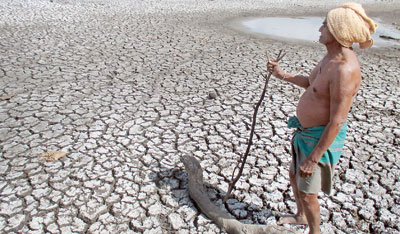
The dried up Saliya Wewa in the North Western Province
The Northern, Eastern and North Central Provinces remain largely dry though these regions have received intermittent rains in the past few days. However, Meteorology Department’s Deputy Director Anusha Warnasooriya has good news for them. She said the dry spell will end with the onset of the Northeast Monsoon any time between the middle of this month and the end of the month. There will be heavy rains in the region in the early parts of next month, she added.
The deputy director said the heavy rains now being experienced in some parts of the country during the tail end of the Southwest Monsoon were due to the formation of a convergence zone in the atmosphere near Sri Lanka.
According to the Met Department, the highest rainfall of 135mm was reported from Ratnapura on Thursday while the Colombo city, Ratmalana, Katunayake and Galle also received more than 100mm of rain. The drought-hit Polonnaruwa district received 58mm of rain on Wednesday but during the following days till yesterday, it did not experience any significant rainfall.
Disaster Management Centre Deputy Director Pradeep Koddippili said the DMC was continuing to supply water and dry rations to the drought-affected people in Anuradhapura and Polonnaruwa despite some rain. He said the Northern and Eastern Provinces still remained largely dry.
The DMC official said the prolonged drought has affected nearly 2 million people, with several irrigation tanks running dry, disrupting crop cultivation.
Mr. Koddippili said the Centre had spent nearly Rs 2 billion on drought relief.
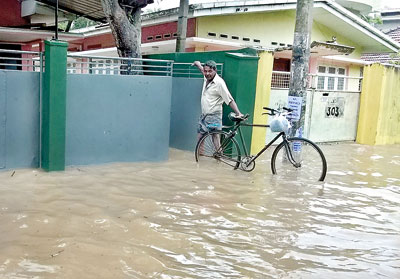
Galle
Polonnaruwa’s Additional District Secretary Sujantha Ekanayake said the rainfall the district experienced this week had hardly helped raise the water levels in irrigation tanks for farmers to start cultivation. He said even drinking water was scarce and the Secretariat had been supplying drinking water to some 7,000 families in Thamankaduwa, Alahara, Dimbulagala, Welikanda and Alahara, while some 7,729 families in 128 Grama Niladhari Divisions received dry rations.
“Smaller tanks are completely empty, while water levels in big tanks such as Minneriya and Parakrma Samudra are also dwindling. Farmers are eagerly awaiting the rains to start cultivation,” he said.
In the neighbouring Anuradhapura district, drinking water and drought relief in the form of dry ration have been provided to some 21,000 families for the past three months, according to the district’s DMC office Deputy Director K.S.D. Bandara.
The situation in the Ampara district — the eastern rice bowl – is no different. District Secretary K. Vimalanathan said the rain this week was hardly adequate to quench the drought and the Secretariat was continuing to send water bowsers to 11 divisions, including Maha Oya, Padiyathalawa, Uhana, Pottuvil and Lahugala.
The DMC’s Ampara District’s Assistant Director A.S.M. Ziyard said the centre would continue to provide dry rations and water to the affected people for another two months even if the district experienced rains in the coming weeks. This was because it would take at least two months to recharge groundwater levels for the farmers to start cultivation, he added.
In the Trincomalee district, too, the DMC and the district secretariat said they would c
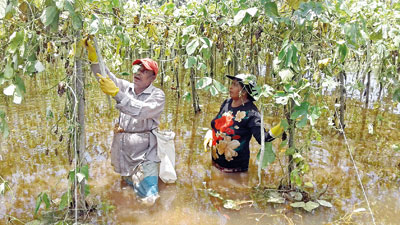
Kalutara in the South: Attempting to salvage what's left of a 78-acre vegetable plot under water
ontinue to provide drought relief to the affected people because the rain that had been lashing the south of the country in the past one week had only made a sprinkling presence in the district.
Explaining the crisis situation, Irrigation Department Director Wasantha Bandara Palugaswewa said that 73 major tanks coming under the department had been left with only 14 percent of water, while the colossus Parakrama Samudraya which could hold 770,000 acre feet of water had now only 60,000 acre feet of water or has been reduced to 7.8 percent of its capacity. In the 85,000 Acre feet capacity Padaviya Wewa, now holds only 6,000 acre feet of water.
However, the drought has provided an opportunity for the department to renovate some of the tanks.
“The Met Department announced that the Northeastern monsoon will begin in October. Therefore, we started renovating tanks by employing farmers who have lost their means of livelihood,” he said.
Meanwhile, as heavy rains are experienced in the Western, Central, Sabaragamuwa and Southern provinces, authorities have placed district and divisional secretaries and DMC officials on disaster preparedness mode.
DMC deputy director Kodippilli said that with this week’s floods in Ratnapura and other areas, some 10,000 people had been affected. He said the DMC had advised district and divisional secretaries to take necessary measures to evacuate people living in landslide-prone areas.
Gamapaha district’s Additional Secretary Anura Priyabandu said he had advised the divisional secretaries of Wattala, Biyagama and Kelaniya to move people who lived in lowland areas and along river banks to safety.
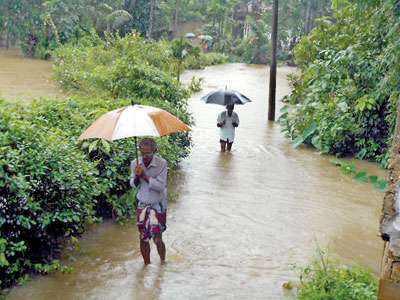
Deniyaya
He said arrangements had been made to house the displaced people in temples and schools. The Secretary said the water level in the Kelani river had not reached spill level, but if the rains continued, the low-lying areas could face flood situation.
Mr. Priyabandu said that to minimise the effects of a likely flood disaster, they had dredged the Kalu Ela (canal) in the Wattala area in anticipation of the rains.
The official said the permanent solution was to relocate the people living in low lying areas on high grounds under a development plan.
Galle was one of the districts that experienced floods following this week’s heavy rains. Additional District Secretary Kamal Ranasinghe said several town areas came under water after the district received more than 100mm of rain within a short period, leading to blockage in several water outlets and large drains.
The areas affected were Balapitiya, Kosgoda and villages near the Maadu Ganga estuary.
Mr. Ranasinghe said flood waters receded after the estuary was dredged and drains and irrigation canals were cleared. He said a canal system was being constructed in the district to prevent floods.
Meanwhile following landslide warnings from the National Building Research Organisation (NBRO), people living in landslide prone areas in the Ratnapura District were being evacuated to safer places, according to District Secretary Malani Loku Pathagama.
She said that suitable temporary shelters were being provided to the evacuees, but some families were refusing to leave or not cooperating with the officials.
“The NBRO identifies the risk areas and we act on its advice to remove people from such areas before the disaster occurs,” she said.
The NBRO has also issued similar warnings to the Kalutara and Galle districts.
Kalutara District Secretariat officials said they issued several warnings to people living on the banks of the Kalu Ganga, urging them to move to safer places before the areas were flooded.
They were being sheltered in camps at Bulathsinhala and Pallenuwara.
Nuwara Eliya’s District secretary K.H.K. Meegasmulla said that so far no landslides had occurred in the district though people living in landslide-prone areas had been told to be prepared for evacuation at the first sign of danger.
She said the DMC and District Secretariat officials were vigilant to act before disaster struck.
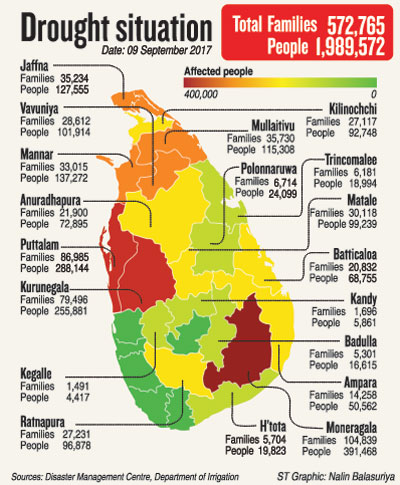
Pix by Sarath Siriwardane, Jayaratne Wickramaarachchi and Sirangika Lokukarawita

